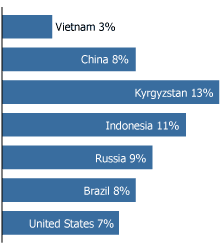
The Dual Burden of Overweight and Underweight in Developing Countries
(March 2006) Undernutrition remains a devastating problem in many developing countries—affecting over 815 million people and causing more than one-half of all child deaths.1 But while governments in these countries continue efforts to reduce hunger, that focus neglects the growing rate of overweight and obesity in the developing world.2 Increasingly, health systems in poor countries are simultaneously confronting under- and overnutrition—not only at the national level, but also within households.
Underweight and overweight people within the same household (often called a dual burden household) pose a significant challenge for nutrition interventions, since programs targeted at underweight individuals may conflict with those targeted at the overweight. To be fully effective, interventions should promote nutritious foods that improve health outcomes at both ends of the nutrition spectrum.3
But changing individual dietary and activity patterns is the biggest challenge. Public health programs and government interventions can play a critical role in educating people about healthy lifestyle choices and improving access to healthy foods.
Two Forms of Malnutrition
Both undernutrition and overnutrition are linked with a range of adverse health conditions. The underweight (defined as having a body mass index or BMI of less than 18.5) are susceptible to poor maternal and infant health as well as childhood growth problems and compromised mental development.4 Meanwhile, obesity (defined as a BMI of more than 30) is associated with such chronic diseases as stroke, hypertension, cardiovascular disease, type-2 diabetes, and certain forms of cancer.5
Obesity in childhood may also lead to a higher risk for adult onset of these chronic diseases.6 And recent research indicates that undernutrition during early-life can later lead to overweight (defined as a BMI between 25 and 30) or obesity by prompting energy conservation mechanisms in the body that can persist into adulthood.7
Importantly, however, underweight and overweight are both forms of malnutrition, a term that encompasses either a lack of or excess in energy and/or nutrients. Crucially, both underweight and overweight individuals may lack important dietary nutrients—minerals and vitamins—that are needed for good health.8 Vitamin A deficiency and iron deficiency anemia are two examples of conditions that affect both underweight and overweight people.
Emergence of the Dual Burden
The dual burden household is a relatively new phenomenon and is most prevalent in middle-income countries such as Kyrgyzstan, Indonesia, and Russia, where between 9 percent and 13 percent of households contain both an underweight and an overweight member (see Figure 1).9 Dual burden households are less common in low- and high-income countries. Low-income countries such as Vietnam tend to have a higher prevalence of underweight, while high-income countries such as the United States tend to have a higher prevalence of overweight (7 percent).10
Figure 1
% of Households With An Underweight and Overweight Member*

*Data for selected countries are rounded and adjusted for household size. Dates vary: Vietnam, 1992-1993; China, 1993; Kyrgyzstan, 1993; Indonesia, 1993; Russia, 1996, Brazil, 1989; and the United States, 1988-1994.
Source: C. Doak et al., “The Dual Burden Household and Nutrition Transition Paradox” (2005).
Among children in developing countries, underweight is still a greater problem than overweight. But many countries (such as Morocco, Guatemala, and the Dominican Republic) have experienced a rising trend in the prevalence of overweight children. In Morocco, for example, the percentage of overweight children more than tripled between 1987 and 2004, from 2.7 percent to 9.2 percent. In a shorter time period (from 1991 to 2002), the percentage of overweight children in the Dominican Republic more than doubled from 2.8 percent to 6.5 percent.11
The emergence of the dual burden household is a result of the nutrition transition underway in developing countries that are becoming more prosperous and urbanized. These countries are seeing a decrease in physical activity levels and a shift in diets to include more fats and sugars.12 With the globalization of food markets, developing countries have larger quantities of low-cost, high-calorie foods. Influential marketing persuades poorer households to purchase more of these cheap foods.13
The excess energy from these foods may affect adults and children within the same household differently. For example, young children may easily use up the excess energy and still be underweight, while adults may end up gaining weight.14 Physical activity levels and food distribution within the household may also vary from one family member to another, further contributing to the under/overweight phenomenon. Research regarding the underlying causes of the dual burden household is limited and warrants additional study.15
Public Health Grapples With the Dual Burden
Dual burden households present a unique challenge for public health. Interventions aimed at reducing undernutrition (such as increasing household food supply) often contradict obesity prevention programs. And interventions to reduce overweight or obesity may recommend a reduced fat diet, with adverse effects on any underweight members in the same household.16 Thus, programs should promote nutritious foods and a healthy lifestyle to address both types of malnutrition at the same time.
High-quality diets—those that consist of sufficient energy and nutrients but are limited in fats, sodium, and sugars—benefit those at risk of either undernutrition or overnutrition.17 Eating more fruits and vegetables helps the overweight (by reducing the risks of heart disease and diabetes) while also helping the undernourished (by improving their nutrient intake). Similarly, an increase in physical activity with adequate energy and protein intake can help build critical muscle mass and contribute to a healthy body composition in both groups.18
However, public health programs alone are not enough. Poor households are often unable to afford healthier foods. Governments therefore must play a key role in monitoring and regulating the food market. By alleviating price constraints, government intervention—for example in the form of food subsidies—can improve access to healthy foods.19
Unifying the Approach to Underweight and Overweight
Governments can look to the World Health Organization’s guidelines for improving nutritional status. In 2004, the World Health Organization adopted the Global Strategy on Diet, Physical Activity, and Health, with recommendations and policy options for promoting healthier diets and increasing physical activity levels.20
According to Mercedes de Onis, a nutrition expert with the World Health Organization, governments that treat overweight and underweight populations with discrete programs need to rethink their approaches.
“The problems of over- and undernutrition are not simply a problem of rich or poor, respectively,” says de Onis. “On the contrary, all too often these problems overlap and coexist. Currently, strategies to tackle this dual burden of malnutrition are often pursued and promoted independently, as if the two problems were independent of each other. This will need to change, and policies and programs developed that address both issues in an integrated manner.”
And since most population growth over the next three decades is expected to occur in urban areas of developing countries, the impact of urbanization on dietary habits and activity levels will require special attention.21
“The changing trends in diets and lifestyles indicate the need for close monitoring and preventive action to improve nutritional status as developing countries undergo the nutrition transition,” says de Onis.
Marya Khan is a research associate with the Population Reference Bureau.
References
- Laura Caulfield et al., “Undernutrition as an Underlying Cause of Child Deaths Associated with Diarrhea, Pneumonia, Malaria, and Measles,” American Journal of Clinical Nutrition 80, no. 1 (2004): 193-98; and Food and Agriculture Organization (FAO), The State of Food Insecurity in the World 2005: Eradicating World Hunger—Key to Achieving the Millennium Development Goals (Rome: FAO, 2005), accessed at www.fao.org, on Jan. 12, 2006.
- Data on the overall prevalence of overweight and obesity in developing countries are limited and vary considerably from country to country.
- Colleen Doak et al., “Overweight and Underweight Coexist within Households in Brazil, China, and Russia,” The Journal of Nutrition 130, no. 12 (2000): 2965-71.
- Food and Agriculture Organization (FAO), “The Spectrum of Malnutrition Fact Sheet,” accessed at www.fao.org, on Jan. 23, 2006. Body mass index is calculated by dividing an individual’s weight in kilograms by their height in meters squared.
- WHO, “Obesity and Overweight Fact Sheet,” (2003) accessed at www.who.int, on Jan. 23, 2006.
- Mercedes de Onis and Monika Blossner, “Prevalence and Trends of Overweight among Preschool Children in Developing Countries,” American Journal of Clinical Nutrition 72, no. 4 (2000): 1032-39.
- Benjamin Caballero, “A Nutrition Paradox—Underweight and Obesity in Developing Countries,” New England Journal of Medicine 352, no. 15 (2005): 1514-16.
- FAO, The State of Food Insecurity in the World 2000: Food Insecurity—When People Live with Hunger and Fear Starvation (Rome: FAO, 2000), accessed at www.fao.org, on Jan. 12, 2006.
- The income classifications are based on the GNP comparison of the seven countries, as stated by the authors in Colleen Doak et al., “The Dual Burden Household and Nutrition Transition Paradox,” International Journal of Obesity 29, no.1 (2005): 129-36.
- Doak et al., “The Dual Burden Household and Nutrition Transition Paradox.”
- De Onis and Blossner, “Prevalence and Trends of Overweight among Preschool Children in Developing Countries”; and WHO, WHO Global Database on Child Growth and Malnutrition, accessed at www.who.int, on Jan. 30, 2006.
- Barry M. Popkin and Penny Gordon-Larson, “The Nutrition Transition: Worldwide Obesity Dynamics and Their Determinants,” International Journal of Obesity 28, supplement 3 (2004): S2-S9.
- Caballero, “A Nutrition Paradox.”
- Caballero, “A Nutrition Paradox.”
- Doak et al., “Overweight and Underweight Coexist within Households in Brazil, China, and Russia.”
- Doak et al., “The Dual Burden Household and Nutrition Transition Paradox.”
- Corinna Hawkes et al., “Diet Quality, Poverty and Food Policy: A New Research Agenda for Obesity Prevention in Developing Countries,” SCN News 29 (2005): 20-22.
- Doak et al., “The Dual Burden Household and Nutrition Transition Paradox.”
- Hawkes et al., “Diet Quality, Poverty and Food Policy.”
- For more information on this strategy, see WHO, “Global Strategy on Diet, Physical Activity, and Health” (May 2004), accessed at www.who.int/dietphysicalactivity/goals/en, on Jan. 23, 2006.
- Caballero, “A Nutrition Paradox.”






